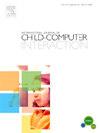Deploying computation-based Making projects in authentic public school classrooms at scale: Lessons learned
Q1 Social Sciences
International Journal of Child-Computer Interaction
Pub Date : 2025-06-05
DOI:10.1016/j.ijcci.2025.100738
引用次数: 0
Abstract
Making has historically encompassed electronics and digital fabrication technologies. Increasingly, Making projects have started incorporating computational aspects. For example, a microprocessor board is attached to electronics and 3D-printed components so that they can be programmed to perform certain functions. Adding computation to Making enables a creation to become more dynamic and interactive. However, incorporating computation into Making also increases the difficulty of integrating Making into formal educational settings not only because students need to handle an additional set of skills and concepts, but also in terms of the additional overhead in preparation. This work deployed computationally-based Making activities in authentic 5th and 6th grade (ages 10 to 12) science classrooms with 442 students in a public school in the United States for one year. Our research adopts the Design-Based Research (DBR) methodology, and this paper presents insights from our retrospective process of reflection, especially in terms of the challenges of integrating computation-based Making in the school context. Our findings indicate four key challenges to incorporate computation-based Making projects in the formal public school context on a sustained basis; achieving balance between science, Making, and computational thinking, making connections between these distinct concepts apparent, organizational and operational issues, and the delivery of designed lesson plans. Despite these challenges, we believe the potential for a positive impact is large. We make two primary contributions; a comprehensive description of an at-scale computation-based Making project as well as learnings for future Making work in formal educational settings.
在真实的公立学校教室中大规模部署基于计算的制作项目:经验教训
制造在历史上包含了电子和数字制造技术。越来越多的制作项目开始纳入计算方面。例如,微处理器板连接到电子和3d打印组件上,这样它们就可以被编程来执行某些功能。将计算添加到制作中可以使创作变得更加动态和交互式。然而,将计算整合到制作中也增加了将制作整合到正规教育环境中的难度,这不仅是因为学生需要处理一组额外的技能和概念,而且还因为准备过程中的额外开销。这项工作在美国一所公立学校的442名学生为期一年的时间里,在真实的五年级和六年级(10至12岁)科学教室中部署了基于计算的制作活动。我们的研究采用了基于设计的研究(DBR)方法,本文提出了我们回顾反思过程的见解,特别是在将基于计算的制作整合到学校环境中的挑战方面。我们的研究结果表明,将基于计算的制作项目持续地纳入正式的公立学校环境中存在四个关键挑战;在科学,制造和计算思维之间取得平衡,在这些明显的不同概念,组织和操作问题之间建立联系,以及设计课程计划的交付。尽管存在这些挑战,但我们相信,积极影响的潜力很大。我们有两个主要贡献;全面描述了一个大规模的基于计算的制作项目,以及在正规教育环境中学习未来的制作工作。
本文章由计算机程序翻译,如有差异,请以英文原文为准。
求助全文
约1分钟内获得全文
求助全文
来源期刊

International Journal of Child-Computer Interaction
Social Sciences-Education
CiteScore
7.20
自引率
0.00%
发文量
73
 求助内容:
求助内容: 应助结果提醒方式:
应助结果提醒方式:


